14 best air purifying plants
Indoor air pollution is one of the major concern. There are many remedies which can help in the reduction of indoor air pollutions. Among them are air purifying plants, air purifiers, and proper ventilation. Air purifying plants are the easiest, cheapest and an aesthetic source to handle indoor air pollution. Along with adding beauty to the indoor environment, it also provides a biological comfort to the indoor environment. Air purifying plants helps in purifying certain harmful gases and decrease the indoor air pollution.
Indoor air purifying plants, and how to take care of them?
1. Areca palm air purifying plant
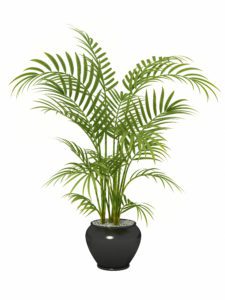
Belongs to family Arecaceae and botanical name is Chrysalidocarpus lutescens.
Removes acetone, xylene, and toluene from indoor air (1).
Know more about benefits of Areca palm >>
How to take care of Areca palm
Areca palm indoor plant is one of the best air purifiers. Areca palm growth rate mainly depends upon the environment. In the wild condition most of the plants grow up to 100 feet while in the indoor condition, it grows up to 6-7 feet. The main source of Areca palm propagation is by seed. The plant requires good light with proper aerated soil and its lifespan is about 10 years. Regular repotting and proper nourishment in every two years are necessary to avoid Areca palm turning yellow.
2. Bamboo palm air purifying plant
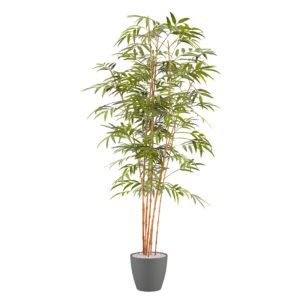
Bamboo palm is scientifically known as Chamaedorea seifrizii.
Helps in providing moisture in the air by evaporating water via photosynthesis. Also helps in removing some potent harmful indoor gases like benzene, trichloroethylene, and formaldehyde (1).
Know more about benefits of Bamboo Palm >>
How to take care of Bamboo palm
Bamboo palm is an easy maintenance plant. Regular irrigation and proper nourishment in the form of fertilizers during its growth season are sufficient enough.
A healthy bamboo palm can reach up to a height of 5 to 7 ft with a width of 3 ft having 10 to 15 fronds per stem. Regular cutting of brown dead leaves and occasional spraying of the leaves with mild detergent water helps in protecting the plant from mites and other infiltrations
3. Peace lily air purifying plant
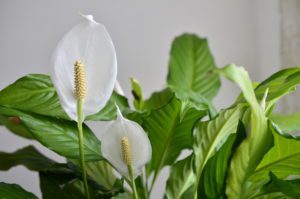
The peace lily is a beautiful evergreen perennial herbaceous plant of genus Spathiphyllum.
One of the easy growing and easy maintaining indoor plant with beautiful white flowers. It helps in absorbing benzene and trichloroethylene.
Know more about benefits of Peace lily >>
How to take care of Peace lily plant
Proper irrigation of plant is necessary. Fertilizers fortified with nitrogen, phosphorus, and potassium (N:P:K 20:20:20) is enough for good growth. Water-based fertilizers should be used for peace lily.
Regular cleaning of leaves, proper aerated soil, and indirect sunlight are the three main factors for a good and healthy peace lily plant.
4. Boston fern air purifying plant
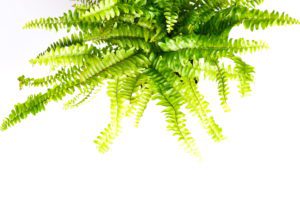
Sword fern or Boston fern is scientifically known as Nephrolepis exaltata.
Acts as a humidifier give a nice cool and calm ambiance. Absorbs pollutants like xylene, formaldehyde, and toluene.
Know more about benefits of Boston fern>>
How to take care and propagate of Boston Fern
Any plastic container hanging pots or decorative pots are used for the growth of this fern. The Boston fern should be potted in well aerated, well drained and high water-holding capacity medium so that the fern does not get dry. We can prepare in-house fern media by mixing 50 % peat with vermiculite of perlite and pine bark for fertilization. Proper watering according to the environment is necessary and avoid direct sunlight. Propagation is simply by dividing the clumps.
5. Poinsettia

Poinsettia is an indoor decorating plant originate in Mexico and scientifically known as Euphorbia pulcherrima.
It is a beautiful plant with red and green leaves. In a study done it was found that poinsettia plants are able to remove formaldehyde from the closed chamber (2).
Know more about benefits of Poinsettia >>
How to take care of Poinsettia
Like other indoor plants, Poinsettia also needs proper indirect bright sunlight for at least 4 to 5 hours a day. Proper irrigation once every 3 days or water whenever the top soil gets dry. Do not over irrigate the plants because excess water may rot the root. Moderately fertilize the plant after blooming. Prune the plant in the month of June or July in order to rebloom the plant for the next season.
6. Snake plant
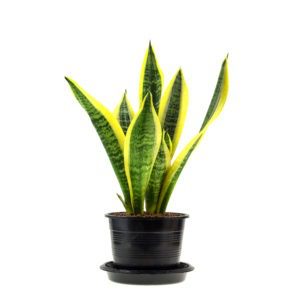
Snake plant is scientifically known as Sansevieria trifasciata. It is native of tropical countries like India, Indonesia, and Africa.
Snake plants help in removing benzene, formaldehyde, xylene, ozone, and toluene from indoor air. It also has a higher efficiency in absorbing carbon dioxide (3, 4).
Know more about benefits of snake plant >>
How to take care of a Snake plant
Unlike other plants, the snake plant is a very tolerant plant. It can survive drought, low light. Maintenance of this plant is very easy. Irrigate the plant whenever the topsoil of the pots dry up. don’t over water the plant as it results in rotting of the plant. irrigate the plant every alternate week is sufficient for its good growth. Snake plant requires medium light and nourish the plant with organic fertilizers once in every year.
7. Spider plant
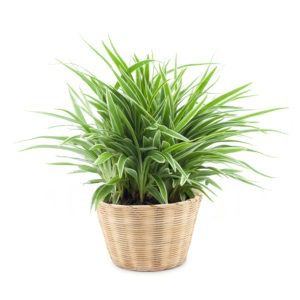
Spider plant or Chlorophytum comosum is an ornamental indoor plant native of Africa.
A study was done in 1994 in Germany (5) shows that spider plants are very effective against formaldehyde and ozone absorption from indoor air.
Know more about Spider plant >>
How to take care of a Spider plant
Growing and maintenance of spider plant are relatively easy.
- Direct sunlight is preferable for the spider plant to grow.
- Water the plant daily during summer season or alternatively during the winter season.
- Fertilizers with normal N, P, K is sufficient for the plant.
8. Anthurium
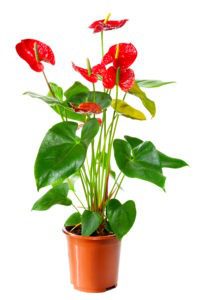
Anthurium andraeanum (Flamingo lily) plant is a decorative indoor air purifying plant with a bright colored leaf known as a spathe.
According to NASA clean air study, the plant anthurium can efficiently remove formaldehyde, xylene, and ammonia from indoor air.
Know more benefits about Anthurium andraeanum >>
How to take care of Anthurium plant
Anthurium plants require lower temperature, indirect light and proper aerated soil with medium water retention capacity. Overwatering of the plant should be avoided as it rots the roots of the plant. As an indoor plant, it requires half a mixture of potting soil and half perlite. Anthurium plants are mainly propagated through stem cutting. Top crown of the plant when removed the bottom leaves remains in the pot developed roots. Proper caring of the remaining plants develops healthy baby plants from the bottom leaves.
9. Rubber plant
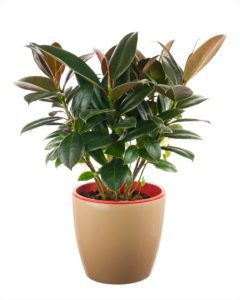
Rubber plant or botanically known as Ficus elastica Roxb. is a large or medium house plant with beautiful foliage. The plant is indigenous to India.
Helps in removing formaldehyde from indoor air according to NASA clean air study.
Know more about benefits of Rubber plant >>
How to take care of a Rubber plant
Rubber plants require indirect sunlight, irrigation every 2 to 3 days. Proper aerated soil is essential for healthy roots. Normal liquid fertilizers (N, P, K) are enough for nourishing the rubber plant. Cleaning the leaves with dry soft cloths once every week for proper absorption of the harmful gases and emission of clean air.
10. Lemon balm
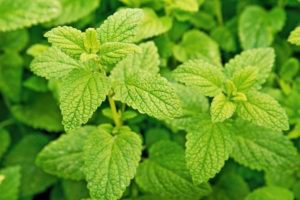
Lemon balm (Melissa officinalis) is an indoor plant. Required low or indirect light.
Along with absorption of foul air, it also provides a fresh fragrance to the indoor environment.
Know more about benefits of Lemon Balm >>
How to take care of a Lemon balm plant
The plant requires sunny weatheror sunlight for its proper growth and development and well aerated sandy soil with rich in organic matter.
11. Golden Pothos
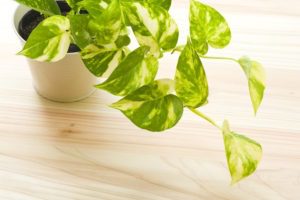
Golden pothos is also known as Epipremnum aureum. Pothos plants are widely used as an indoor plant in houses and offices because of its large attractive leaves.
This plant is effective against reducing ozone concentration, formaldehyde. Nitrogen dioxide and carbon monoxide from the indoor environment (4).
Know more about benefits of Golden Pothos >>
How to take care of a Pothos plant
Pothos plants are easy maintenance plant. simple regular watering with once in a year nourishing the plant with fertilizers is enough.
12. Syngonium
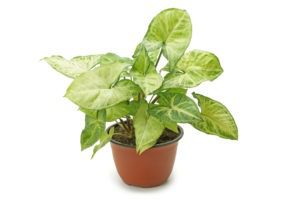
Syngonium or Nephthytis (Syngonium podophyllum) is an evergreen plant requires semi sun to the shady environment for its growth. These beautiful decorative plants can either grown in pots or in hanging conditions.
This plant can effectively remove indoor pollution by releasing more oxygen and absorbing formaldehyde from indoor air (6).
Know more benefits about syngonium >>
How to take care of Syngonium
Syngonium plant requires low to medium light. The soil should be rich in humus along with good draining and aerating capacity. The soil should be moist for the better growth of the plant. Water daily or alternate day depending upon the temperature of the environment. Use liquid fertilizer for good growth. Regular misting is required during dry weather otherwise normal misting once in two or three days is enough for its proper and healthy growth.
13. Lady palm
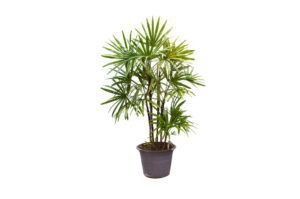
Lady palm or Rhapis excelsa grows up to 4 m height and is native to China and Taiwan. Mode of propagation is mainly via rhizomes. This is easy to care plant helps in resisting insects and indoor air pollutants.
Know more benefits about lady palm >>
14. English Ivy

English ivy scientifically known as Hedera helix also known as European ivy or only ivy, is a native to Europe.
This plant is also one of the easy to grow indoor plants requires semi shed to the shed environment. According to NASA plants list for indoor plants for clean air, this plants helps in absorbing carbon dioxide and formaldehyde from the environment.
Know more benefits about English Ivy >>
How to take care of English ivy
Ivy plants need an appropriate amount of water not much more and not much less. Regular irrigation after slight dryness of the topsoil is necessary. Spraying with water monthly or every 15 days keeps the plant healthy. Nourishment of soil with liquid fertilizer is also important.
References
- https://www.researchgate.net/file.PostFileLoader.html?
- Wolverton Environmental Services Inc. (1991) “Removal of Formaldehyde from Sealed Experimental Chambers, by Azalea, Poinsettia and Dieffenbachia”, Res. Rep. No. WES/100/01-91/005.
- International Conference on Chemical, Metallurgy and Material Science Engineering (CMMSE-2015) August 10-11, 2015 Pattaya, Thailand
- https://pdfs.semanticscholar.org/2ebb/696d0ccd82fff6b63aa83527e408acf9f0e4.pdf
- https://www.ncbi.nlm.nih.gov/pmc/articles/PMC159294/pdf/1041301.pdf
- Wolverton, B.C., Mcdonald, R.C. & Watkins, E.A. Econ Bot (1984) 38: 224. https://doi.org/10.1007/BF02858837
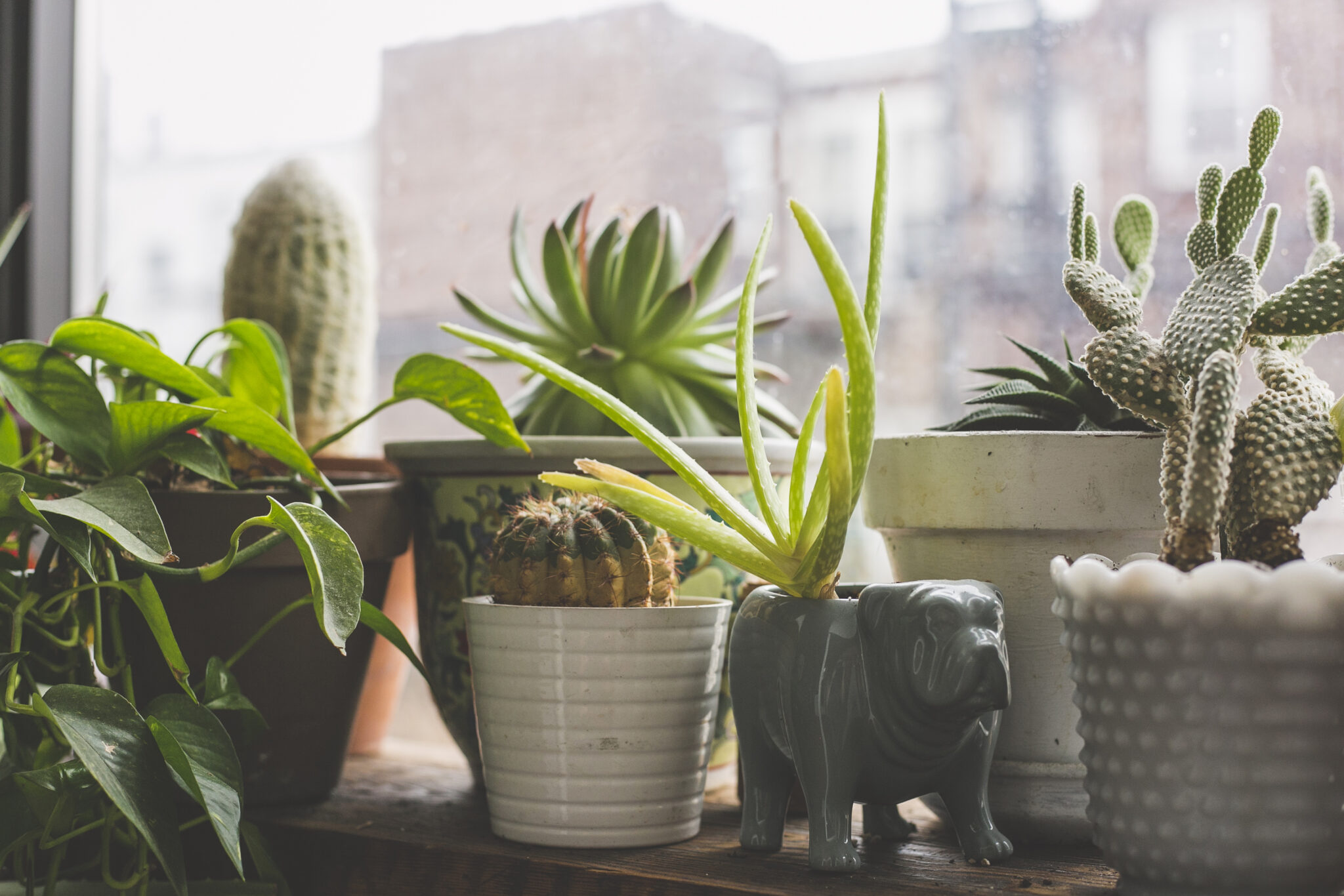
[…] Top Air purifying plants […]
[…] Top Air purifying plants […]
[…] Top Air purifying plants […]
[…] Top Air purifying plants […]
[…] Top Air purifying plants […]
[…] Top Air purifying plants […]
[…] Top Air purifying plants […]
[…] Top Air purifying plants […]
[…] Top Air purifying plants […]